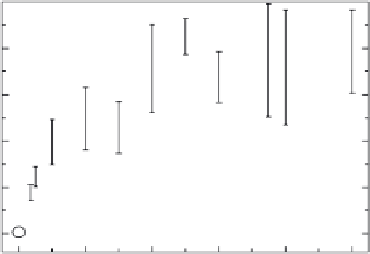Biomedical Engineering Reference
In-Depth Information
500
400
300
200
100
0
0
20
40
60
80
100
EDC concentration (mg/mL)
FIGURE 8.5
Surface Young's modulus
E
0
determined by AFM nanoindentation technique for various EDC concentrations
up to 100 mg/mL. An exponential asymptotic fit to data is also represented (thick line). Error bars represent
standard deviation of 6 to 16 measurements of
E
0
corresponding to various approach velocities. (Reproduced
with permission from Francius et al.,
Microsc. Res. Tech.
, 69, 84-92, 2006. Copyright Wiley-VCH Verlag GmbH &
Co. KGaA.)
A few recent approaches to adjusting the mechanical properties of PEMs are based on
photo-cross-linking. One major advantage to photo-cross-linking is that it offers the pos-
sibility of patterning PEMs. Yang and Rubner (2002) extensively demonstrated the proofs
of concept for this type of cross-linking.
Pozos-Vásquez et al. (2009) also reported on the preparation of polyelectrolyte films
based on PLL and HA derivatives modified by photoreactive vinylbenzyl (VB) groups.
The VB-modified HA incorporated into the films was cross-linked on UV irradiation, and
the force measurements taken by AFM proved that the rigidity of the cross-linked films
was increased up to fourfold.
100
400
(a)
(b)
350
80
300
60
250
200
40
150
100
20
50
0
0
0
20
40
60
80
100
120 140
160
0
20
40
60
80
100
EDC (mg/ml)
% reduction of carboxylic groups
FIGURE 8.6
(a) Percentage of carboxylic groups remaining in film after cross-linking procedure, as a function of initial EDC
concentration. (b) Film Young's modulus
E
0
plotted as a function of percentage of reduction of carboxylic groups
(band at 1610 cm
−1
). Also shown is a regression line with the error interval (95%, dashed lines).






































Search WWH ::

Custom Search